Hyrox Wall Ball guide: Perfecting your technique
Unlock your Hyrox wall ball potential with our comprehensive guide. Discover expert tips, techniques, and strategies to boost your performance.


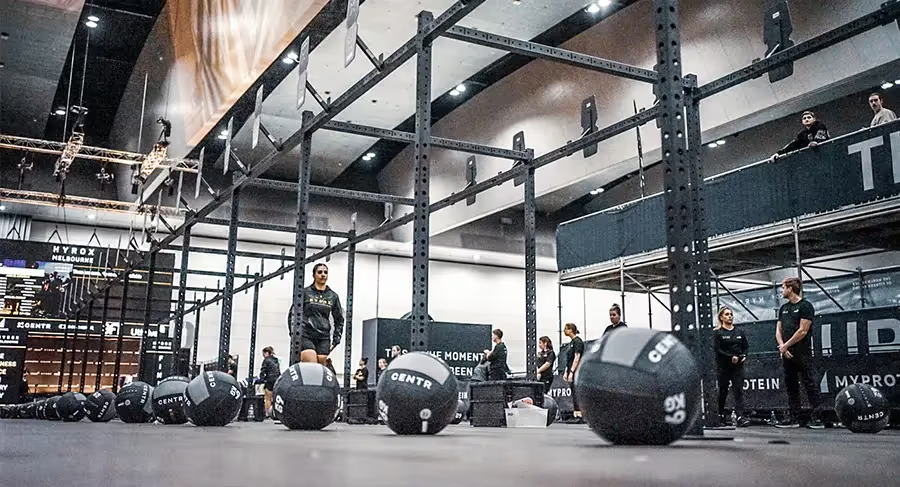
Unlock your Hyrox wall ball potential with our comprehensive guide. Discover expert tips, techniques, and strategies to boost your performance.


With HYROX races gaining more and more popularity across the globe and in the CrossFit space we set out to provide insightful knowledge on how to best prepare for these races no matter your starting level.
Combining the 10+ years experience in functional fitness of our coaches with tested and proven methods in HYROX racing we are releasing a YouTube and blog post series to help all athletes achieve their goals in this new hybrid adventure.
Next up in the series is the wall ball station.
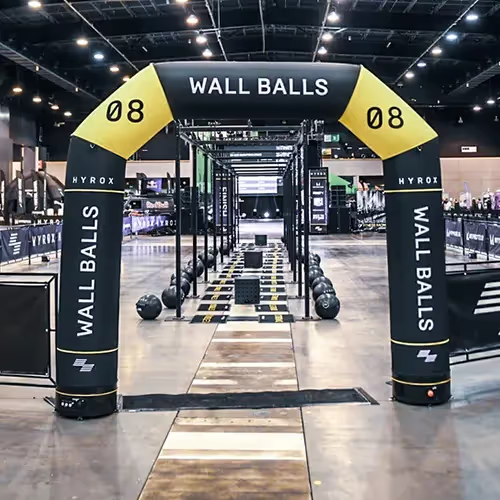
As one of the more complex movements we see across the race, wall balls can be much more tricky than athletes anticipate, causing extreme variability in time spent completing them.
But with a few smart moves in training and quick fixes to form you can expect to crush them.
" frameborder="0" allow="autoplay; fullscreen; picture-in-picture" allowfullscreen>
The wall ball requires the athlete to complete a below parallel front squat holding a medicine ball at shoulder height. As he comes out of the squat he’ll throw the ball towards a target, therefore performing a vertical pressing movement. The rep is complete when the ball touches the target.
Wall balls are a movement performed with the use of a specific medicine ball and a target.
The med-balls used for this exercise need to not just be appropriately heavy but have enough “cushioning” to give them the proper size and soften the blow in the case they aren’t caught properly or simply fall to the ground.
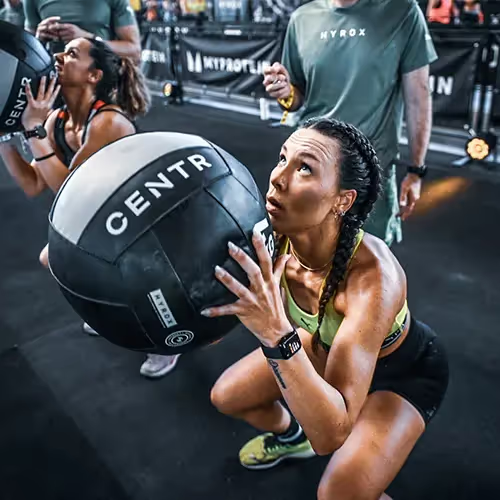
Additionally, they require a target the ball will have to touch or clear for the rep to be considered valid. These targets can take on many forms from an X or a line on a wall that has to be crossed to metal plates fixed onto structures which the ball had to be aimed at.
Usually you will see these targets set at two standard heights, one for females and one for males.
In HYROX races you will find that the target used is of the second type, made up of a metal bullseye that you must hit. This is important to note if you are used to training with a target drawn on a wall as your reference distances will be affected.
The wall ball station is the last station you will be going up against in your race.
So even though you may be familiar with this exercise, especially if you’re coming from CrossFit, you will still have to face some challenges you may not expect.
You will have ran 8 km by the last station and completed several tests that will have worn out your shoulders and especially legs, so it’s important to be aware of the conditions you’ll be in when training them.

Women: 75 Reps * 9lbs (4 kg) ball – to 9-foot target
Women Pro: 100 Reps * 14lbs (6kg) ball – to 9-foot target
Men: 100 Reps * 14lbs (6kg) ball – to 10-foot target
Men Pro: 100 Reps * 20lbs (9kg) ball – to 10-foot target
Mixed Doubles: 100 Reps * 14lbs (6kg) ball – to 9-foot target
Women Doubles: 75 Reps * 9lbs (4kg) ball – to 9-foot target
Men Doubles: 100 Reps * 14lbs (6kg) ball – to 10-foot target
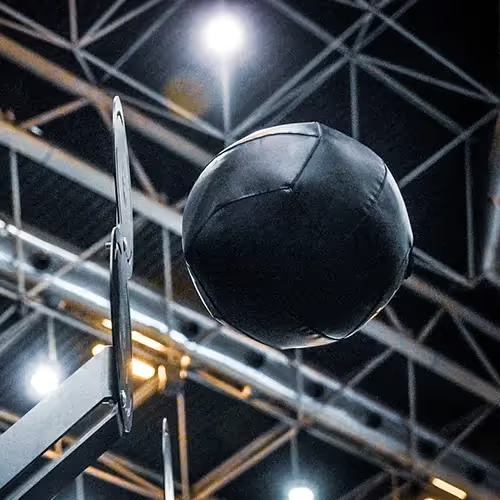
You will find that the targets at HYROX race have the shape of an eight, with the top “circle” being the designated target spot for men and the bottom is for the womens.
If you fail to hit this target, the rep will be invalid and therefore not counted.
Additionally, if you don’t fully lock out your hips and extend your knee after picking up the ball and before starting your first rep, said rep will be considered invalid.
Lastly but perhaps most importantly, you must break parallel on each squat.
This mean your hip crease must be lower than the top of you knee, achieving a lesser than 90-degree angle.
This is certainly the standard most athletes struggle with either due to lack of mobility, poor understanding of the squatting mechanics or simply their hope of shaving of some time, and range of motion, from their reps but ultimately making things worse.
Don’t forget every no rep you get is not just more time on your score but more work that you will ultimately have to do.
So do yourself a favor and train good clean reps.
" frameborder="0" allow="autoplay; fullscreen; picture-in-picture" allowfullscreen>
Or you can also check out this in depth blog post on how to perfect the wall ball: Wall Ball best tips.
The most obvious but the one we still see too much of is getting no repped.
You are actively giving yourself more work to do while slowing yourself down so it is quite obvious how it’s a situation you want to avoid at all costs.
We most commonly see no reps dished out for two reasons: athletes tried to go for too big of a set and can’t hit the target anymore due to fatigue.
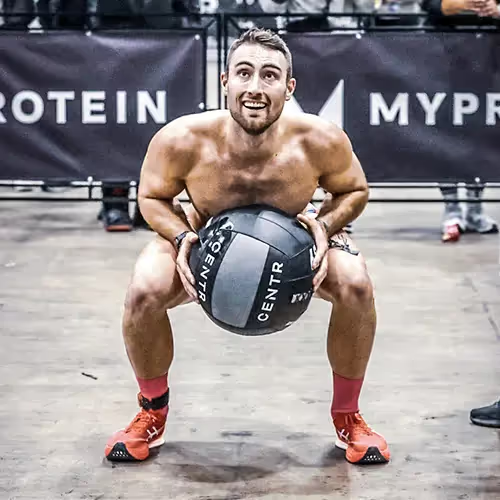
Or worse, they are trying to shorten their squat and not hitting parallel.
Luckily both these problems have a quick fix that goes something like “Don’t be stupid”.
Fatigue will creep up on you by the last station so unless you know you can bang out a HUGE set of wall balls even when tired aim to be conservative at least on the first few chunks of reps.
And always, always, always aim for clean reps that won’t get you slowed down because they are deemed no reps.
Other common mistakes we see are:
improper breathing patterns: we recommend inhaling on the way down and exhaling on the way up. If you are fast on your reps, you can even inhale-exhale every two reps. No matter what you do find a pattern and stick to it to avoid hyperventilating.
not having a reference for how far to be from the target: there is no set distance you should be from your wall ball target. But you MUST find the distance that works for you and your mechanics and learn how to measure it/have a distance point of reference to utilize on race day, so you always know exactly where to set up for your shots.
hunching over as you fatigue: this is going to make it harder for you on so many levels, you’ll back will have to work more to bring you upright as you throw the ball, it will be harder to breathe, and your arms will fatigue faster. Be disciplined with your core and it will pay dividends.
not training in similar conditions to race day: you need to know how it feels approaching the wall ball station post 8 km run and severely fatigued to be mentally ready to take on the challenge.
not paying attention to your hands: how and where your place your hands will impact how heavy the ball will feel, how precise and efficient each throw is and if done incorrectly, especially when tired and sweaty, increases the chances of the ball slipping through your hands on the way down.
Quick tip: hands always go UNDER the ball not at its sides.
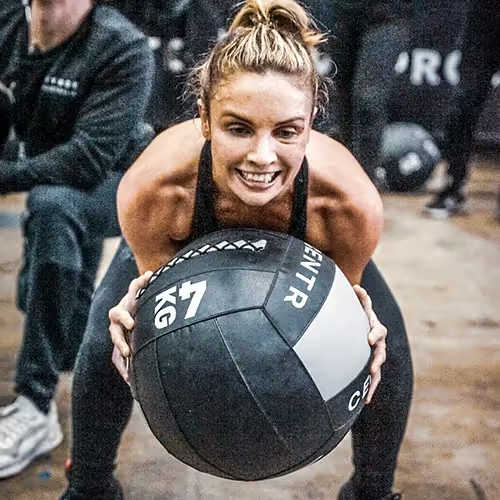
don’t wait for the ball to hit you: if you’re already comfortable with the movement but want to improve efficiency, start learning how to descend into a squat for the next rep before catching the ball. This will remove some time under tension for your shoulders and increase rep speed.
When we boil it all down, the wall ball is essentially a slightly more explosive front squat.
It requires much of the same mobility and strains the torso and upper body in the same manner a front squat does.
So improving your front squat both from a strength perspective as well as mobility is most likely to benefit your performance and scores long term.
Similarly we recommend approaching the warm up for wall balls similarly to the one you’d do for a front squat, just without having to spend as much time as you won’t have to be as active from a nervous system point of view.
So what should you prioritize?
Ankle mobilization: calf stretches and then more “actively” tempo calf raises done on a plate to achieve a better stretch are a good place to start.
Hip warm up: internal and external mobility with hip flows like shin boxes.
T-spine mobility: spend some time going through a cat-cow mobility flow or opening up your chest on a foam roller to make sure your T-spine is mobilized enough to support front rack mobility demands.
Need more instructions on how to warm up properly for front squats, thruster or wall balls? Check out this article: The front squat Tutorial
If you are struggling to break parallel but don’t have any issues with it on back squats, you may need to spend more time on your upper body and ankle mobility.
Then test out a few front squats with a medium load (heavy enough for you to need to activate your core and get yourself in the correct front rack positioning).
Go for good but SLOW reps with as much range of motion possible and then try a few wall balls immediately after.
We’ve said it before, we’ll say it again.
This is the LAST station of your race, so you need to learn how to handle reps under lots of fatigue.

If you aren’t prepared for it mentally, your form will suffer, making each rep harder and heavier and even risking you some no-reps, so make sure you are training wall balls in a fatigued state quite frequently.
Tying back to the previous point, this is an exercise where good form pays dividends, especially when it comes to staying upright. Making both mobility and core endurance an important priority if you tend to struggle with this station.
YOU DO NOT WANT TO GET NO REPPED.
And you know what will happen if you are not used to doing wall balls to HYROX standard even while training?
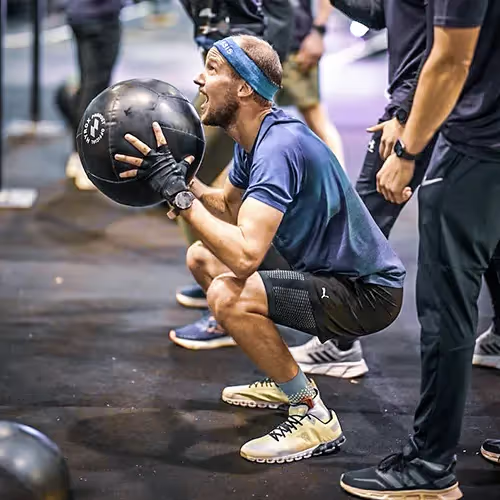
You will start becoming complacent, increasing your chances of adopting the same bad habits on race day and falling behind as you get penalized by no-reps.
This can be tricky, especially if you are used to doing your wall balls with a target painted over a wall.
We recommend trying to practice at least a couple of times with a competition target and experimenting with different distances to find the one you are most comfortable with.
Then either used your extended arm or feet to get a rough estimate of the distance between you, the target and the metal structure supporting the target, so you can always start your set at the same distance from it.
Everyone’s training journey will be a little different. If wall balls are a walk in the park for you, you may not need to spend so much time working on them in training. For others, practicing to refine better technique is crucial.
However, for all cases it’s important to build up your volume, starting from where you’re at, and practicing them under severe fatigue.
If you feel like you’re in need of a more structured training plan that fits your fitness level in order to get you to your race goals, we may have just what you’re looking for.